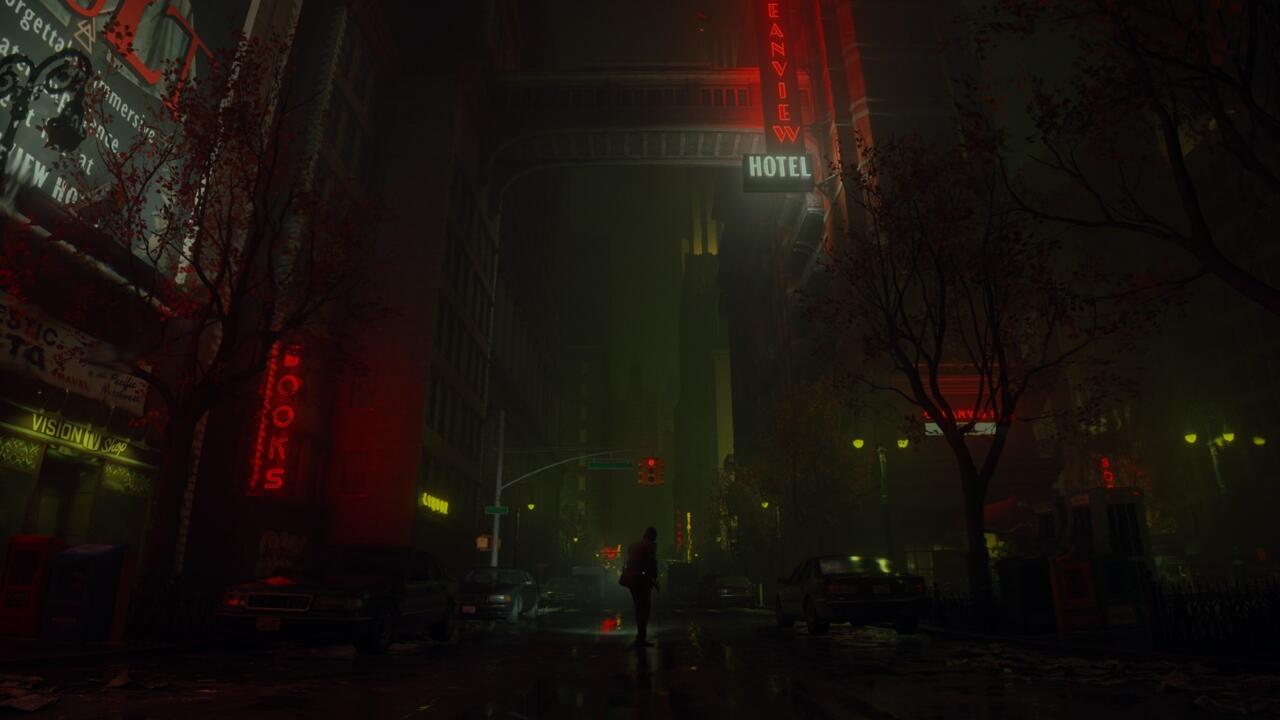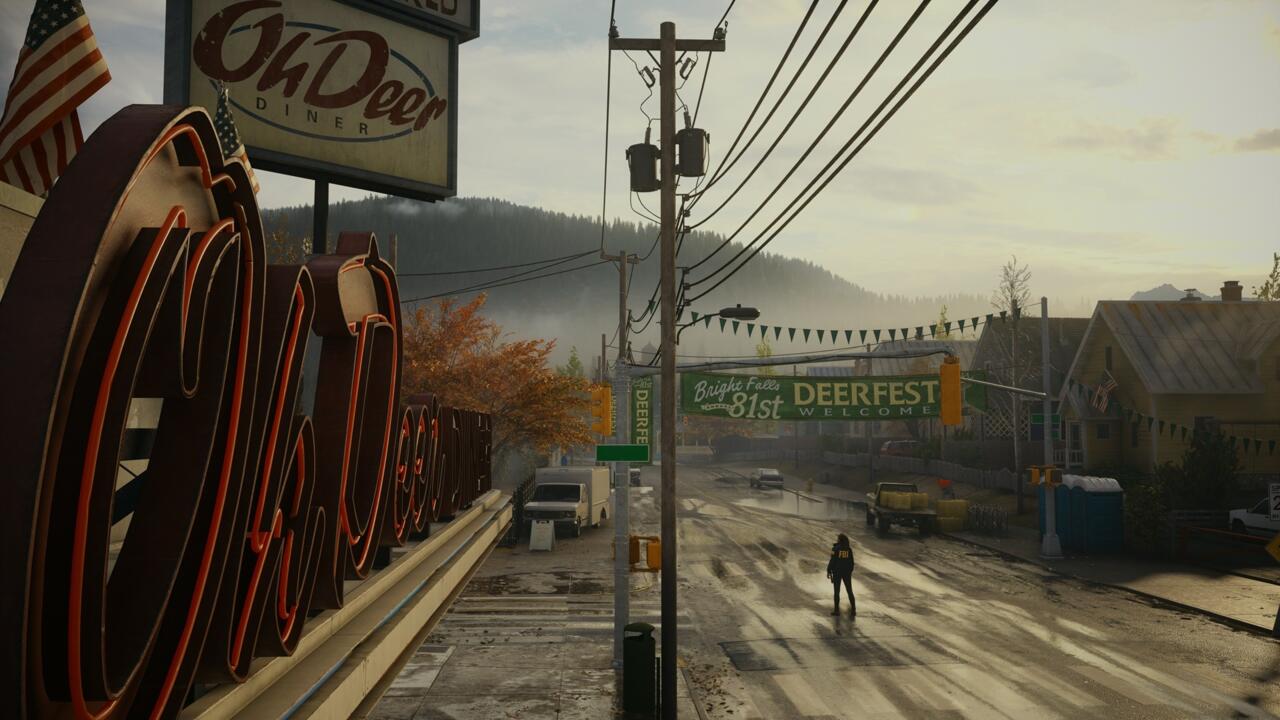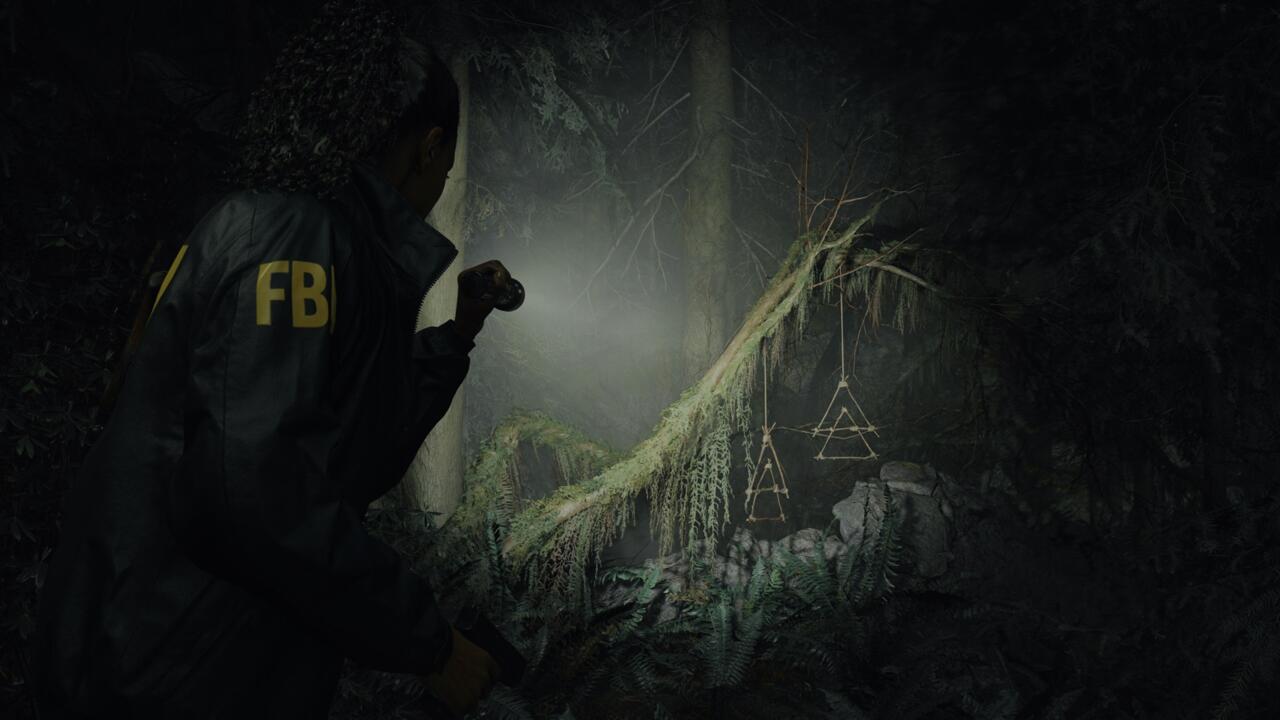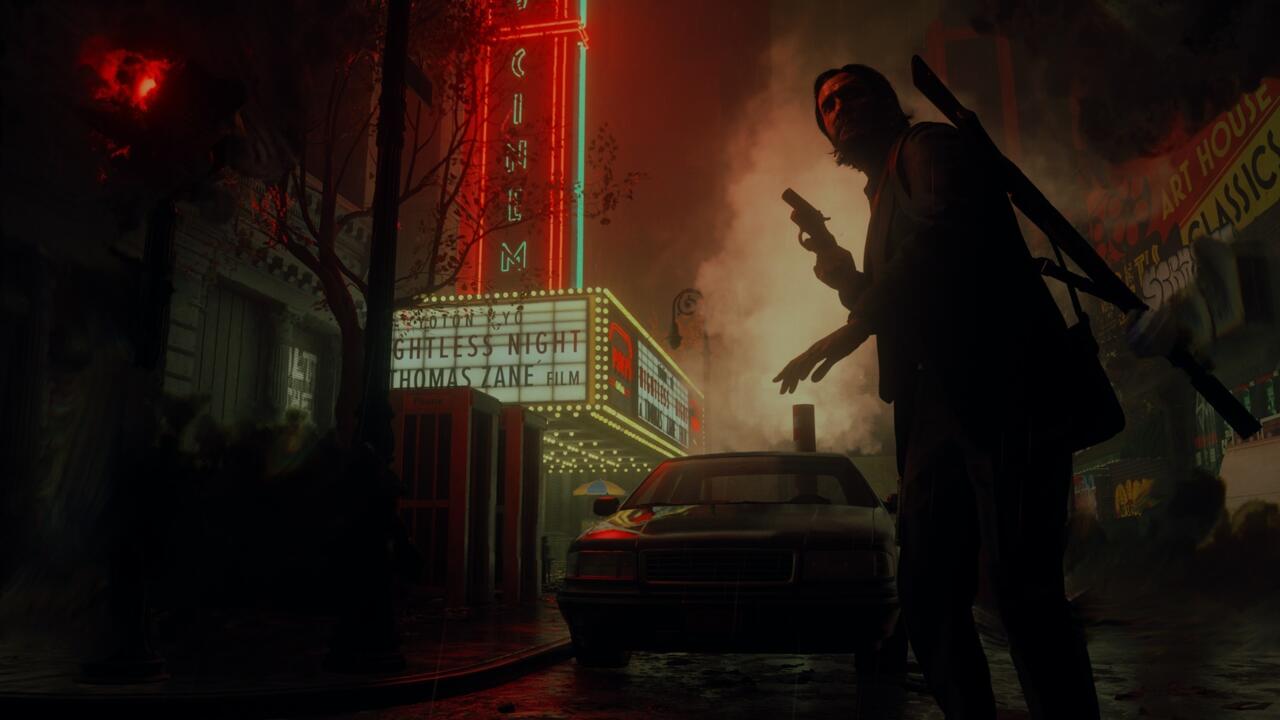Calling a game ambitious can come with an implied caveat. A game with great ambition can be something that reaches high and far, but can also be one that doesn’t quite get there. Alan Wake 2 is one of the most ambitious games I’ve ever played, but don’t misconstrue that, as it doesn’t fall short of its lofty goals. On the contrary, Alan Wake 2 achieves virtually everything developer Remedy Entertainment set out to do. It’s a game that feels novel and risky that is executed with confidence and a clarity of vision. The end result is a one-of-a-kind sequel that redefines its series, blazes trails in video game storytelling, and stands as the monument to a studio that has unlocked its potential to the fullest.
Picking up 13 years after the original game’s events, Alan Wake 2 is made with two audiences in mind: those who may be new to its mystery-laden plot and those who have been decorating figurative cork board with red strings in their minds for over a decade. This is a smart way to broaden appeal to a bigger audience that Remedy executes by splitting the game into two campaigns, both unfolding using an unconventional structure.
In one campaign, FBI special agent Saga Anderson arrives at the once-quaint Bright Falls, Washington to investigate a series of disappearances and ritualistic murders. Saga is joined by her partner, Alex Casey, and becomes the perfect proxy for the uninitiated as she is soon enveloped in the juxtaposition of Bright Falls’ understated but haunting atmosphere and its quirky and often upbeat townsfolk. Turning over crime scenes in an unsettling forest rich in folklore, Saga’s storyline combines the rustic foreboding feelings of The Blair Witch Project with the unflinching grit of a Fincher-esque dark crime drama. The other campaign, meanwhile, sees you play as the titular Alan Wake and picks up in a nightmare realm called the Dark Place, where Alan has been trapped since the end of the first game. This malevolent space feeds off of art and memories alike, creating a personalized prison for all who enter it.
As different as they are, the two storylines feel equally crucial to the plot. Though it can be tempting to mainline one story before moving to the other, the game makes a compelling case for embracing the intertwined nature of the narrative. Players can switch between protagonists at frequent intervals using interaction points found in many of the game’s safe rooms, adding a storytelling touch that brings out so much personality and can also drastically alter the experience. Having said that, the narrative doesn’t lose any luster if you choose to take the one-then-the-other approach.
Saga’s and Alan’s stories bleed into one another at times, and somehow Remedy has ensured that the tonal shifts never detract from the overall experience, and instead offer more texture. Depending on the order in which you experience each chapter, you might have one sequence come across as sinister and foreshadowing, while another player that has taken a different path may see the same events as dramatic irony, knowing the hero is walking into wickedness. By playing all angles, the full story comes into view, which is especially well-handled and well-hidden, given how fiction blends with reality and time moves differently in the Dark Place, making the truth of any scene feel murky.
While 2010’s Alan Wake had horror elements to it, Alan Wake 2 is a true survival-horror experience, complete with many of the genre’s established touchpoints. As either character, you’ll need to manage a puzzle-like inventory, find respite from approaching monsters in safe rooms, and try your best to line up headshots with a variety of guns you typically unlock from some sort of locked display case.
In the original game, combat encounters were meant to be tense, but not exactly scary, as evidenced by its frantic gameplay that consisted of bobbing and weaving around half a dozen monsters at a time. Here, the action slows down and tends to involve fewer but hardier enemies–a recipe that’ll be familiar to horror fans. Managing a small horde of different Taken enemies, often each with their own attack patterns, becomes an engrossing exercise in survival.
Their intent is often to flank and smother you, but like they did in the first game, others may lead from the back and chuck axes at your head, demanding you time your dodges well. I enjoyed how these Taken look and largely still behave like the ones I’d seen in the original Alan Wake, but each is spongier and smarter, meaning instead of dispatching perhaps multiple enemies with one round of ammo like I could in the first game, in Alan Wake 2 I’d more often have to evade and buy myself time to reload just to take out one enemy. In the first game, you could also hit an enemy with a quick burst of light at no inventory cost in order to stun them and gain some separation. Now, though, batteries are much more limited, and this flashlight technique, though it still critically removes their inky shields, doesn’t do much to ward them off after that. Enemies can also regrow their shields of darkness, meaning you have to choose when to put the pressure on and very intentionally see it through, or else you’ve burned through precious resources for nothing.
It built in me a hyper-awareness of my surroundings and items, as narrow forest paths or a confined cabin could give the enemies an advantage. I’d backpedal through a doorway hoping to funnel the monsters into my trap, but this was a slower, more methodical process that demanded I carefully considered my use of flares, flashbangs, and nearby Safe Haven light fixtures. The original game’s combat loop had a lot of style, but not so much substance. Alan Wake 2 strikes a much better balance in a way that lends itself to its shift toward being a survival-horror game.
In that sense, Alan Wake 2 doesn’t redefine the gameplay leanings of the genre, but it uses them deftly nonetheless. I typically had just enough ammo to get through an encounter, which may have left me limping to the next Safe Haven light that would let me catch my breath and plan my next move through the lush but intimidating forest surrounding Cauldron Lake. Sometimes the best decision was to flee a scene, which would shift the encounter from a gunfight against wispy shadowmen to something more akin to a vicious slasher chase.
One unique Remedy touch that distances Alan Wake 2 from something like Resident Evil or Dead Space is how comfortable it feels in sometimes not forcing players into combat just to pad out the action. Saga’s investigation includes many side cases, such as solving puzzles built around weird nursery rhymes found in the woods, or looking into a mayoral candidate, which has a conclusion you ought not miss. In heading down these peripheral pathways, long stretches without combat are possible, but because the atmosphere is so rich and the world so detailed, I never felt like I was missing something. Instead, I very much wanted to pour over every cabin I could get inside of, where I’d often find not just crucial supplies as the tension built toward my next encounter, but also a litany of items that contribute to worldbuilding, which has been made more exciting than ever now that we know Alan Wake and Control share a single story world.
While foundational survival-horror mechanics are shared across both timelines, their moods, aesthetics, and themes are quite different. Saga’s story plays like a police procedural, allowing the expert criminal profiler to use her almost-supernatural deductive reasoning skills to work through a twisted case of cult murders and bewitched folklore. The backdrop of the gloomy Pacific Northwest is more The Killing than the original game’s Twin Peaks, though the region is still full of peculiar denizens, some of whom are genuinely hilarious–seriously, everyone is going to love the Koskela brothers’ TV ads. These breaks in the horror feel impactful, whether characters remain quirky throughout the story and bring layers to the cast or, as is sometimes the case, when once-lighthearted characters break bad, leaving you feeling uneasy and untrusting.
To further immerse you in the investigation aspect of her mission, you’ll fill out Saga’s Case Board, which winds up having an additional benefit. Not only does it fulfill that detective fantasy of linking clues with taut red strings and cracking the case, but it serves very well as a helpful visual guide through the twisting (and twisted) story. Remembering names, events, and locations becomes much easier when it’s laid out in her mental map, the Mind Place.
Late in the game, my time in the Mind Place involved a bug that demanded I brute-force and troubleshoot my way past a 15-minute scene for about 45 minutes, but Remedy has since deployed a patch that is said to have corrected this. It slightly hampered the pacing of the finale for me, but it didn’t sour the experience overall. While others with the game have reported having a rougher experience, I–and other members of the GameSpot team–have had a smooth experience, barring the aforementioned bug. Again, Remedy has released a pre-launch patch to address several concerns, but there is still the chance that bugs remain.
Given how gorgeous and detailed the game is, I’m curious how some of its technical feats are possible, such as moving seamlessly between the Mind Place and the real world. It seems a testament to the studio’s in-house Northlight Engine that the game can run well, look incredible, and somehow still at times defy my (admittedly limited) understanding of video game tech. And for a game about light and darkness, it’s downright hypnotic in how it uses each scene to create a virtual portrait of its settings, with amber sunlight reflecting through the thick trees around Cauldron Lake as heavy rain soaks the forest, effectively creating a dreary mood.
After more than 15 hours spent mostly in Saga’s timeline, I had already felt like Alan Wake 2 was one of the year’s best games. Then I played Alan’s campaign, which routinely subverts expectations in never-before-seen ways that I dare not spoil. Though we’ve seen other iterations in previous games, Alan’s version of the Dark Place today manifests as a haunted noir metropolis where neon signage and hotel lobbies soaked in smooth jazz are offset by the shadowy assailants that lurk menacingly throughout the ever-shifting city. All the while, Alan finds echoes of Alex Casey conducting an investigation. This is a different Casey than Saga’s partner, with this one coming from Alan’s own crime fiction novels that made him famous before Alan sunk out of the physical world–and this is one of many intentionally crafted points of intrigue and confusion that Remedy expertly plays with.
New to the series, Alan’s Plot Board serves as something of a gameplay analog to Saga’s Case Board, albeit with very different effects. It allows him to alter reality by discovering different story details in a level that are then used like an ability, tool, or weapon upgrade. For example, in the Oceanview Hotel, you might arrive in the hotel lobby, discover an Echo of a Casey story that clues you into how you can alter the scene, and then instantly do so as Alan rewrites his story, which is reflected in-game with a technically impressive instant-switch in the environment. But with the new scene likely come new threats and opportunities, and to progress his journey, Alan’s rewrites must make sense. It’s a subjective puzzle mechanic that asks the player to consider narrative merit, but its rules are clear even as the pathing can be purposely dizzying, so no instance ever balloons too big.
Watching the environment change before my eyes never got old, and often when I’d know which setting and plot details would combine to advance the story, I’d use the alternate options first, like going down the secondary pathway in a traditional horror game with hopes of finding other items of interest before making my next move.
Using a stunning blend of live-action scenes that often spill into the game’s rendered world, Alan Wake 2 frequently offers some of the most elaborate and beautiful imagery I’ve seen in the medium. Remedy has always been in favor of live-action elements in its games, but it’s never been used to this extent or in this particular way. Far from the stop-and-go nature of Quantum Break’s full live-action episodes pulling players out of the game, here it’s more an evolution of a style Remedy first used to great effect with Control’s Hotline segments. In Alan Wake 2 superimposed visions of characters and echoes of voices from another time and place creep into a scene, giving it a layered audiovisual flourish that strangely no one else in video games seems to attempt. Perhaps after Alan Wake 2, we’ll see more studios try something like this, as the Finnish team has unlocked something mesmerizing with expert cinematography, a distinct style, and some wonderful sets that bring the story’s arresting characters and locations to life.
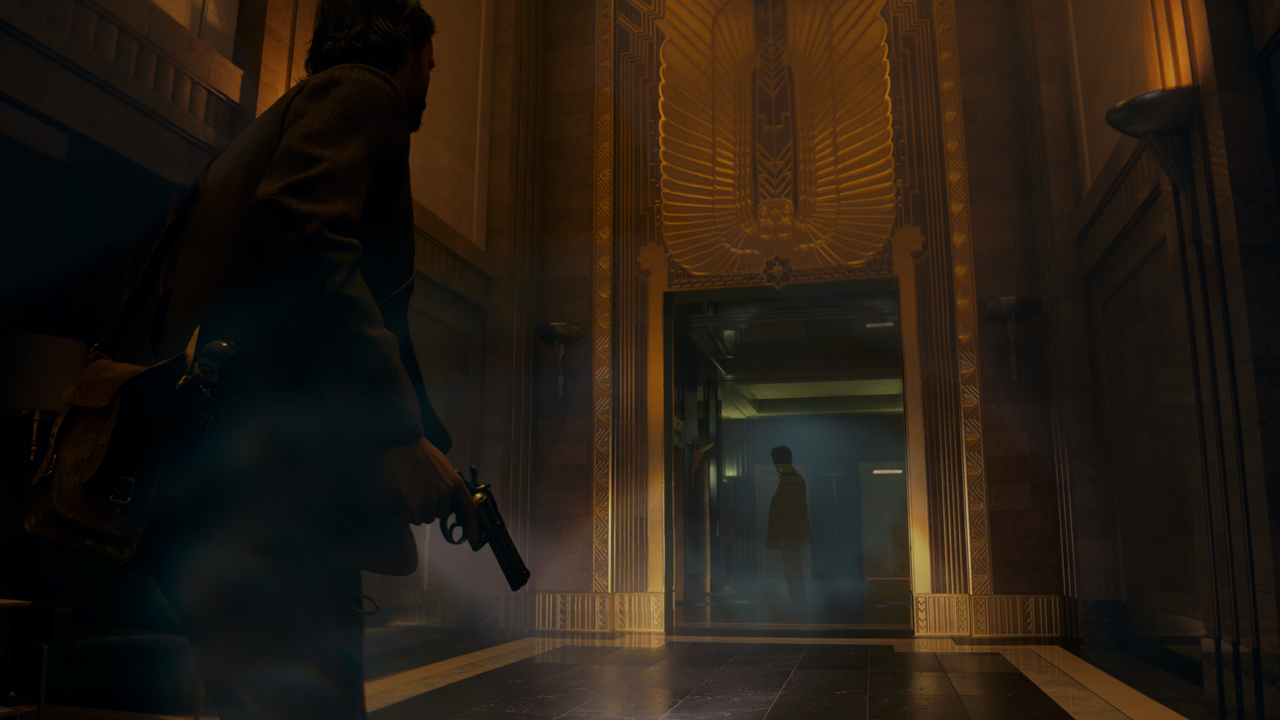
Further enhanced by an intense focus on music that builds upon, and actually outshines, Control’s Ashtray Maze, Alan Wake 2 stretches the definition of what a video game is and becomes an arresting multimedia fantasy that few studios would likely dare attempt. There are multiple scenes in this game, in Alan’s campaign especially, that will surely be poured over and talked about with reverence, much like Control’s Ashtray Maze was. Even if you’ve been waiting for this sequel for a long time and think you know every theory and have explored every inch of the story universe, you are simply not ready for what Alan Wake 2 has in store for you.
That’s another wonderful thing about Alan Wake 2: Not only is it a gorgeous, eccentric, and immersive game, it’s also meta as hell. Alan Wake 2 wraps nightmares inside timeloops tied to a distortion of the monomyth inside a metaphysical world that bleeds into reality, blurs fact and fiction, and spins out doppelgangers in every which way, and it does it all not just to be weird, but to tell an elaborate story about writing, balance, irony, and so much more. As perplexing as it certainly is, and as hazy as some of its answers to mysteries may be, Alan Wake 2 feels like it wants to be understood–it just wants you to sweat a little in getting there, and it doesn’t intend to give away everything yet anyway.
There are parts of this game I interpret to be Remedy talking about its own journey in returning to the world of Alan Wake after such a long time away. It does this in such a layered and lovably strange story that even after Control, which felt like Remedy had stepped up its narrative ambitions significantly, it now seems as though Remedy has found yet another new benchmark for itself, while creating new avenues that we may see replicated by other teams in the future. At one point I worried that Sam Lake, Remedy’s creative director, may be retiring after this because it feels so vision-complete and full of purpose, like a last hurrah. And having finished the game, I wonder how the studio will top it.
The Remedy Connected Universe (RCU) also comes into view like never before in Alan Wake 2, making the game not just an Alan Wake sequel, but also includes a continuation of Control’s story, some (legally transformative) nods to Max Payne and Quantum Break, and an apparent setup for the next RCU game. The details light my brain on fire with the bewildering possibilities and implications Alan Wake 2 creates. The tangled web Remedy continues to weave through its shared story world is exciting and unique even at a time when spin-offs and tie-ins are dominating movies, TV, and games. Though you can enjoy Alan Wake 2 as a singular timesink in your gaming catalog, those who dive in with knowledge of (or a desire to understand) the RCU elements are going to have their minds blown.
The idea of what Alan Wake 2 could be has changed so much over the years, but in playing the game, I was reminded of Sam Lake saying how he was so happy that all the previous versions of this game never worked out, and how excited he was that this is the Alan Wake 2 the world has finally received. I have to emphatically agree. The mere existence of an Alan Wake 2 would have, at different points over the years, felt like a minor miracle, but for it to be this one, that feels singular in its achievements, and coming from a studio that refuses to shy away from the paths less traveled, makes Alan Wake 2 a miracle illuminated.

